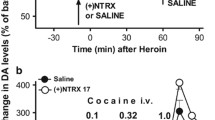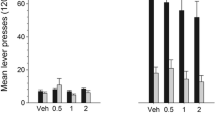Abstract
The involvement of dopamine D1 receptor systems in the reinforcing properties of opiate reward was studied by examining the effect of the dopamine D1 antagonist SCH23390 on the initiation of heroin self-administration in rats. The D1 antagonist was administered daily systemically or locally in the nucleus accumbens (NAC), after which the animals were allowed to self-administer heroin (IV) in a 3-h session for 5 consecutive days. Systemic treatment with SCH23390 (0.17 and 0.5 mg.kg−1) significantly decreased heroin intake during initiation of heroin self-administration, while a dose of 0.06 mg.kg−1 was not effective. Local administration of SCH23390 (0.5 and 2.5 µg/site) in the NAC did not affect heroin intake. Both systemic and intra-accumbal administration of SCH23390 dose dependently decreased motor behavior measured in a small open field. The attenuation of heroin intake during initiation of heroin self-administration by blockade of dopamine D1 receptor systems may be due to a decrease in the reinforcing effects of heroin or more likely to a reduction in non-reinforcement-related behavior. The dopamine D1 receptors present in the NAC are probably not involved in opiate reward.
Similar content being viewed by others
References
Acquas E, Carboni E, Leone P, Di Chiara G (1989) SCH23390 blocks drug-conditioned place preference and place aversion: anhedonia (lack of reward) or apathy (lack of motivation) after dopamine blockade? Psychopharmacology 99:151–155
Barnett A, Iorio LC, Billard W (1986) Relationship of the behavioral effects of SCH23390 and related benzazepines to their effects on dopamine D1 receptors. In: Biggio G, Spano PF, Gessa GL (eds) Modulation of central and peripheral neurotransmitter function. Liviana Press, Padore, Italy, pp 15–25
Bozarth MA, Wise RA (1981) Heroin reward is dependent on a dopaminergic substrate. Life Sci 29: 1881–1886
Britton DR, Curzon P, Mackenzie RG, Kebabian JW, Williams JEG, Kerkman D (1991) Evidence for the involvement of both D1 and D2 receptors in maintaining cocaine self-administration. Pharmacol Biochem Behav 39:911–915
Corrigall WA, Coen KM (1990) Selective D1 and D2 antagonists decrease response rates of food-maintained behavior and reduce the discriminative stimulus produced by heroin. Pharmacol Biochem Behav 35:351–355
Corrigal WA, Coen KM (1991) Cocaine self-administration is increased by both D1 and D2 dopamine antagonists. Pharmacol Biochem Behav 39:799–802
Creese I, Sibley DR, Hamblin MW, Leff SE (1983) The classification of dopamine receptors: relationship to radioligand binding. Annu Rev Neurosci 6:43–71
De Vry J, Donselaar I, Van Ree JM (1989) Food deprivation and acquisition of intravenous cocaine self-administration in rats: effects of naltrexone and haloperidol. J Pharmacol Exp Ther 251[2]:735–740
Ettenberg A, Pettit HO, Bloom FE, Koob GF (1982) Heroin and cocaine intravenous self-administration in rats: mediation by separate neural systems. Psychopharmacology 78:204–209
Goeders NE, Lane JD, Smith JE (1984) Intracranial self-administration of methionine enkephalin into the nucleus accumbens. Pharmacol Biochem Behav 20:451–455
Hoffman DC, Beninger RJ (1985) The D1 dopamine receptor antagonist SCH23390 reduces locomotor behavior and rearing in rats. Pharmacol Biochem Behav 22:341–342
Hubner CB, Koob GF (1990) The ventral pallidum plays a role in mediating cocaine and heroin self-administration in the rat. Brain Res 508:20–29
Hubner CB, Moretor JE (1991) Effects of selective D1 and D2 dopamine antagonists on cocaine self-administration in the rat. Psychopharmacology 105:151–156
Hyttel J (1983) SCH23390 — the first selective dopamine D1 antagonist. Eur J Pharmacol 91:153–154
Kebabian JW, Calne DB (1979) Multiple receptors for dopamine. Nature 277:93–96
Klemm WR, Block H (1988) D1 and D2 receptor blockade have addictive cataleptic effects in mice but receptor effects may interact in opposite ways. Pharmacol Biochem Behav 29:223–229
König JFR, Klippel RA (1967) The rat brain a stereotaxic atlas of the forebrain and lower parts of the brain stem. Krieger, Huntington, New York
Kurumiya S, Nakajima S (1988) Dopamine D1 receptors in the nucleus accumbens: involvement in the reinforcing effect of tegmental stimulation. Brain Res 448:1–6
Leone P, Poddock D, Wise RA (1991) Morphine-dopamine interaction: ventral tegmental morphine increases nucleus accumbens dopamine release. Pharmacol Biochem Behav 39:469–472
Mackey WB, Van der Kooy D (1985) Neuroleptics block the positive reinforcing effects of amphetamine but not of morphine as measured by place conditioning. Pharmacol Biochem Behav 22:101–105
Meyer ME, Cottrell GA, Van Hartesveldt C, Potter TJ (1993) Effects of dopamine D1 antagonists SCH23390 and SK&F83566 on locomotor activities in rats. Pharmacol Biochem Behav 44:429–432
Milner PM (1991) Brain-stimulation reward: a review. Can J Psychol 45:1–36
Molloy AG, Waddington JL (1985) Sniffing, rearing and locomotor responses to the D1 dopamine agonist R-SK&F38393 and to apomorphine: differential interactions with the selective D1 and D2 antagonists SCH23390 and metoclopramine. Eur J Pharmacol 108:305–308
Morelli M, Di Chiara D (1985) Catalepsy induced by SCH23390 in rats. Eur J Pharmacol 117:179–185
Nakajima S, McKenzie GM (1986) Reduction of the rewarding effect of brain stimulation by blockade of dopamine D1 receptor with SCH23390. Pharmacol Biochem Behav 24:919–923
Nakajima S, Wise RA (1987) Heroin self-administration in the rat suppressed by SCH23390. Soc Neurosci Abstr 13:1545
Olds ME (1982) Reinforcing effects of morphine in the nucleus accumbens. Brain Res 237:429–440
Pettit HO, Ettenberg A, Bloom FE, Koob GF (1984) Destruction of dopamine in the nucleus accumbens selectively attenuates cocaine but not heroin self-administration. Psychopharmacology 84:167–173
Radhakishun FS, Van Ree JM, Westerink BHC (1988) Scheduled eating increases dopamine release in the nucleus accumbens of food-deprived rats as assessed with on-line brain analysis. Neurosci Lett 85:351–356
Ramsey NF, Van Ree JM (1990) Chronic pretreatment with naltrexone facilitates acquisition of intravenous cocaine self-administration in rats. Eur J Pharmacol 1:55–61
Ramsey NF, Van Ree JM (1992) Reward and abuse of opiates. Pharmacol Toxicol 71:81–84
Shippenberg TS, Herz A (1988) Motivational effects of opioids: influence of D1 versus D2 receptor antagonists. Eur J Pharmacol 155:233–242
Spyraki C, Fibiger HC, Phillips AG (1983) Attenuation of heroin reward in rats by disruption of the mesolimbic dopamine system. Psychopharmacology 79:278–283
Vaccarino FJ, Bloom FE, Koob GF (1985) Blockade of nucleus accumbens opiate receptors attenuates the intravenous heroin reward in the rat. Psychopharmacology 86:37–42
Van Ree JM, Ramsey NF (1987) The dopamine hypothesis of opiate reward challenged. Eur J Pharmacol 134:239–243
Van Ree JM, Wolterink G (1981) Injection of low doses of apomorphine into the nucleus accumbens of rats reduces locomotor activity. Eur J Pharmacol 72:107–111
Van Ree JM, Slangen JL, De Wied D (1978) Intravenous self-administration of drugs in rats. J Pharmacol Exp Ther 204[3]:547–557
White TJ, Wang RY (1986) Electrophysiological evidence for the existence of both D1 and D2 dopamine receptors in the rat nucleus accumbens. J Neurosci 6[1]:274–280
Wise RA, Bozarth MA (1982) Action of drugs of abuse on brain reward systems: an update with specific attention to opiates. Pharmacol Biochem Behav 17:239–243
Wood PL (1983) Opioid regulation of CNS dopaminergic pathways: a review of methodology, receptor types, regional variations and species differences. Peptides 4:595–601
Yoshida M, Yokoo H, Mizoguchi K, Kawahara H, Tsuda A, Nishikawa T, Tanaka M (1992) Eating and drinking cause increased dopamine release in the nucleus accumbens and ventral tegmental area in the rat: measurement by in vivo microdialysis. Neurosci Lett 139:73–76
Yuan X, Madamba S, Siggins GR (1992) Opioid peptides reduce synaptic transmission in the nucleus accumbens. Neurosci Lett 134:223–228
Zito KA, Vickers G, Roberts DCS (1985) Disruption of cocaine and heroin self-administration following kianic acid lesions of the nucleus accumbens. Pharmacol Biochem Behav 23:1029–1036
Author information
Authors and Affiliations
Rights and permissions
About this article
Cite this article
Gerrits, M.A., Ramsey, N.F., Wolterink, G. et al. Lack of evidence for an involvement of nucleus accumbens dopamine D1 receptors in the initiation of heroin self-administration in the rat. Psychopharmacology 114, 486–494 (1994). https://doi.org/10.1007/BF02249340
Issue Date:
DOI: https://doi.org/10.1007/BF02249340




